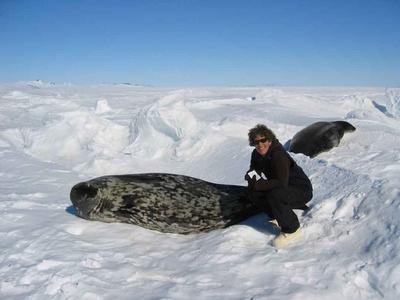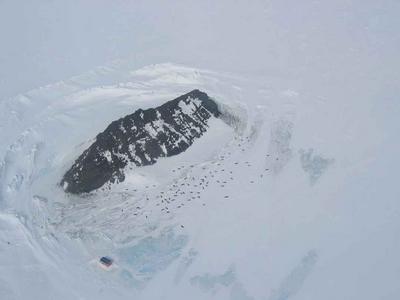5 December, 2003
White Island rises from the ice towards the southern end of Erebus
Bay. With the exception of a tidal crack on its northern side, the
ice around it has been shown to be over 15m thick. The crack has a
few openings that allow seals to move between the ice surface and the
ocean, but the openings are clogged with platelet ice that makes
access to the water difficult. In addition, the island and its tidal
crack are at least 20km from the ice edge during the summer. So why
would any seals live here, and how did they get here in the first
place?
Seal researcher Thomas Gelatt studied these seals as part of a PhD
research project. He hypothesized that the small population of seals
that call White Island home has been isolated from other seals since
1947. That year marks the most extensive break-out of ice ever
recorded in Erebus Bay. That event would have placed the ice edge
close enough to White Island to allow seals to travel under the ice
to its crack. Historically, none of the explorers of the early 1900s
noted any seals at White Island. The first description of seals at
White Island wasn't until 1958, with additional sightings in the
1960s.
Seals at White Island have been tagged and censused annually since
1991. Since then, there has been no evidence of any emigration from
that population-no seals tagged at White Island have been seen
anywhere else in Erebus Bay. In addition, there have been no
untagged adults sighted at White Island since 1992. At its peak, the
population had 26 seals older than pups. With no emigration or
immigration, there has been no introduction of new genetic material
to the White Island seals. Genetic studies of those seals have shown
similarity with the other seals of Erebus Bay, while documenting
inbreeding within the island's population.
Today we conducted the second census of the season at White Island.
The first was done about 2 1/2 weeks ago, with 4 adults sighted and
one new pup tagged. Our helicopter flight took us along the north
edge of the island, flying low enough to see any black seal-like dots
that might be lying along the crack. We made two stops, the first
for a lone seal and the second for a small group of seals that
included the pup that was tagged on the previous visit. The grand
total for seals was 6, including the pup. Last year a total of 9
seals were seen, including 2 pups. This year's total is 8. The
population is decreasing noticeably with each year.
What the future holds for these seals is anyone's guess. Perhaps
there will be another major ice break-out event that will bring the
edge close to White Island and allow mixing with other seal groups.
Without immigration the population will grow increasingly inbred.
Currently, pup survival rates are far lower than those found in other
seal colonies. The pups have a hard time getting through the thick
platelet ice and returning to the surface for air. Larger pups are
probably better able to plow through that thick ice. Adults seem to
have a good rate of survival. If a pup gets through its first few
years, the probability is good that it will survive for many more.
This population provides a unique natural laboratory for studying an
isolated group of animals.
After the census we flew back to camp along the coastline over our
study area. We checked the area to see if there were any significant
groups of seals that had been missed during our censuses of the past
few weeks. In fact, there was a small group at North Base that has
gone undetected-but they are so far back within the glacier and ice
cracks that it would be very difficult to get to them. It was great
to get an aerial view of the study area, and even wilder to look down
and see all those little black spots on the snow at each of the seal
colonies.
Daily Haiku:
The White Island seals
Isolated from others
What will happen next?

Gillian Hadley and one of the White Island seals. The adult seals in this group are noticeably bigger than most of the other seals we've seen in Erebus Bay..

This mother had the only new pup of the year.

In this aerial view of Little Razorback, all those little black dots to the right are seals.
Contact the TEA in the field at
.
If you cannot connect through your browser, copy the
TEA's e-mail address in the "To:" line of
your favorite e-mail package.
|
